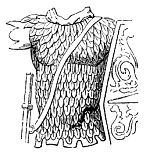Lorica plumata
Lorica Plumata[edit | edit source]
The Lorica Plumata was a type of armor used in the Roman Empire by high-ranking military officers. It is characterized by its unique construction, which combines elements of both chainmail and scale armor. The name "plumata" is derived from the Latin word for "feathered," reflecting the armor's appearance, which resembles the feathers of a bird.
Construction[edit | edit source]
The Lorica Plumata was constructed by attaching small, feather-like metal scales to a backing of chainmail. Each scale was individually riveted to the mail, creating a flexible yet protective surface. This design allowed for greater mobility compared to other types of Roman armor, such as the lorica segmentata.
The scales were typically made of iron or bronze, and the underlying chainmail was crafted from interlocking metal rings. This combination provided excellent protection against slashing and piercing attacks while maintaining a relatively light weight.
Usage[edit | edit source]
The Lorica Plumata was primarily worn by centurions and other high-ranking officers within the Roman legions. Its intricate design and the skill required to produce it made it a symbol of status and prestige. Unlike the more common lorica hamata or lorica segmentata, the Lorica Plumata was not issued to regular soldiers due to its complexity and cost.
Advantages and Disadvantages[edit | edit source]
The main advantage of the Lorica Plumata was its combination of flexibility and protection. The armor allowed for a greater range of motion than the rigid lorica segmentata, making it ideal for officers who needed to move freely while commanding troops.
However, the Lorica Plumata was also more expensive and time-consuming to produce. The intricate work required to attach each scale to the chainmail backing meant that it was not practical for mass production. Additionally, the armor required regular maintenance to prevent rust and ensure that the scales remained securely attached.
Decline in Use[edit | edit source]
As the Roman Empire evolved, so did its military tactics and equipment. The decline of the Lorica Plumata can be attributed to several factors, including changes in military strategy, the increasing cost of production, and the availability of more efficient armor types. By the late Roman period, the use of Lorica Plumata had largely diminished, replaced by simpler and more cost-effective armor solutions.
Related Pages[edit | edit source]
Search WikiMD
Ad.Tired of being Overweight? Try W8MD's physician weight loss program.
Semaglutide (Ozempic / Wegovy and Tirzepatide (Mounjaro / Zepbound) available.
Advertise on WikiMD
|
WikiMD's Wellness Encyclopedia |
| Let Food Be Thy Medicine Medicine Thy Food - Hippocrates |
Translate this page: - East Asian
中文,
日本,
한국어,
South Asian
हिन्दी,
தமிழ்,
తెలుగు,
Urdu,
ಕನ್ನಡ,
Southeast Asian
Indonesian,
Vietnamese,
Thai,
မြန်မာဘာသာ,
বাংলা
European
español,
Deutsch,
français,
Greek,
português do Brasil,
polski,
română,
русский,
Nederlands,
norsk,
svenska,
suomi,
Italian
Middle Eastern & African
عربى,
Turkish,
Persian,
Hebrew,
Afrikaans,
isiZulu,
Kiswahili,
Other
Bulgarian,
Hungarian,
Czech,
Swedish,
മലയാളം,
मराठी,
ਪੰਜਾਬੀ,
ગુજરાતી,
Portuguese,
Ukrainian
Medical Disclaimer: WikiMD is not a substitute for professional medical advice. The information on WikiMD is provided as an information resource only, may be incorrect, outdated or misleading, and is not to be used or relied on for any diagnostic or treatment purposes. Please consult your health care provider before making any healthcare decisions or for guidance about a specific medical condition. WikiMD expressly disclaims responsibility, and shall have no liability, for any damages, loss, injury, or liability whatsoever suffered as a result of your reliance on the information contained in this site. By visiting this site you agree to the foregoing terms and conditions, which may from time to time be changed or supplemented by WikiMD. If you do not agree to the foregoing terms and conditions, you should not enter or use this site. See full disclaimer.
Credits:Most images are courtesy of Wikimedia commons, and templates, categories Wikipedia, licensed under CC BY SA or similar.
Contributors: Prab R. Tumpati, MD

